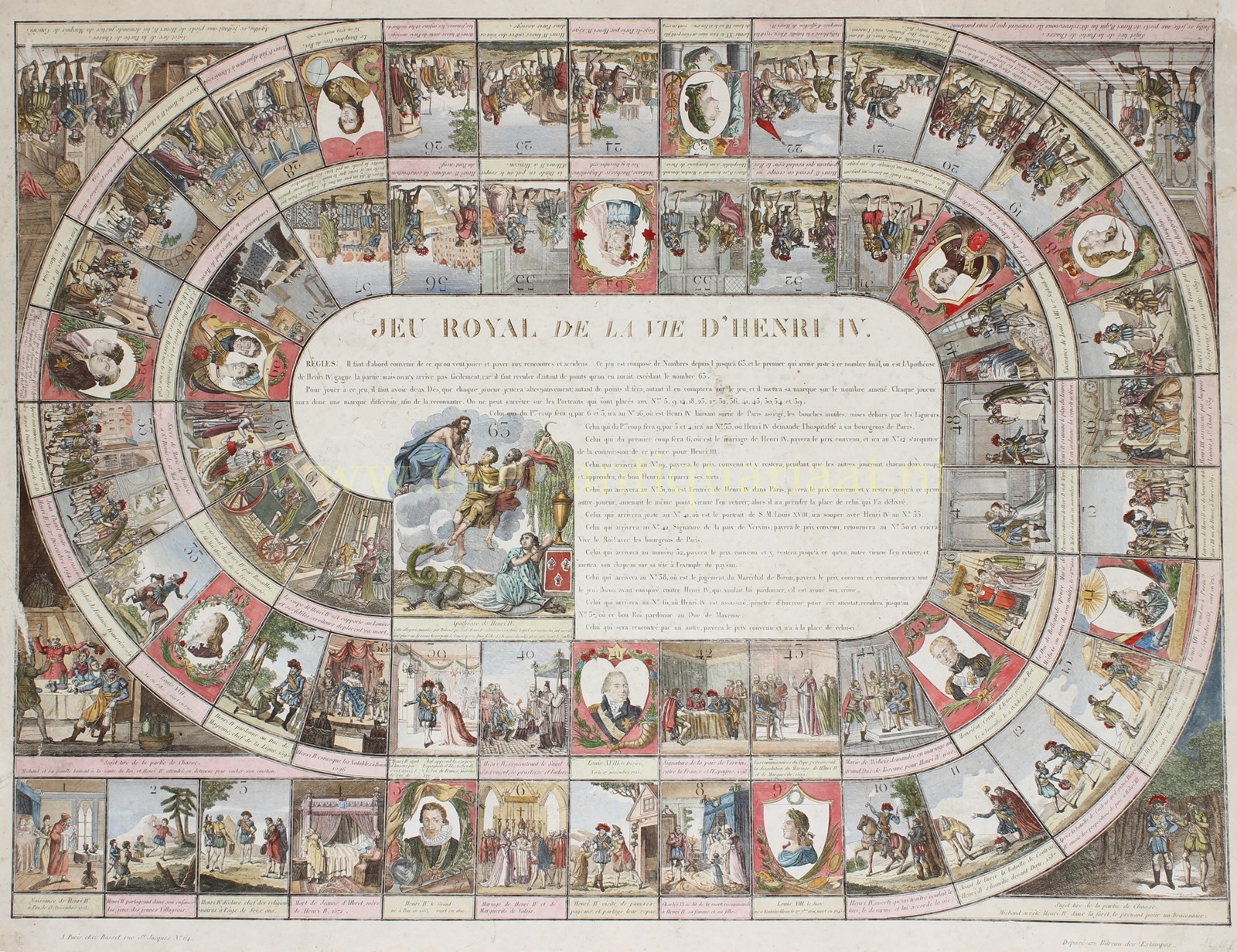PROPAGANDA FOR THE FRENCH MONARCHY
“Jeu Royal de la vie d’Henri IV,” copper engraving made by Paul André Basset around 1820. Coloured by a later hand. Size: 47 x 63 cm.
This large sheet features a visually animated “Goose game” with 63 numbered squares, spiraling counterclockwise and centripetally focused on the French king Henri IV (1553-1610).
The engraving offers a pictorial journey through Henri IV’s life, from his birth to his apotheosis (after a painting by Rubens). The route is carefully constructed in chronological order, punctuated by significant political events, marriages, battles, and moments of peace. The game depicts Henri IV as a sovereign who is close to his people and merciful. For instance, it shows him sharing a meal with poor peasants (n° 7), allowing women, children, and the elderly to leave besieged Paris (1590) (n° 26), and at the Louvre welcoming (with a kiss) a peasant from Béarn bringing a traditional cheese (n° 51). He is a monarch with a vison when he orders the construction the Pont Neuf (n° 26).
The game’s “historic” comments highlight key quotes from the king, such as “rally to my panache!” during the Batlle of of Ivry (n° 20), and his famous wish that “I want there to be no peasant so poor in my kingdom that he does not have a chicken in his pot every Sunday” (n° 57).
The game emphasizes the king’s role as the restorer of civil peace, with the memory of religious conflicts, such as the Massacre of St. Bartholomew’s Day, being absent. Notably, the depiction of his marriage to Marguerite de Valois (1572) (n° 6) excludes any mention of the bloody religious wars.
Medals of royal family members through time – from Henry IV (n° 3), via Louis XIV (n° 14) until a double portrait of the Duke and Duchess of Berry (n° 59) – appear on the game’s every four or five squares, emphasizing the House of Bourbon‘s connection to Henri IV. They are all family of ‘Henri le Grand’.
The engraving is dated around 1820, coinciding with the assassination of the king-to-be, the Duke of Berry, in that same year. These were turbulent times in France, following the French Revolution and the rise and fall of Napoleon. With the monarchy in distress, this game was intended as royal propaganda, suggesting that Charles X (the younger brother of Louis XVIII), being a descendant of Henry IV, would also be a good monarch when he succeeded to the throne. (Charles X would eventually reign between 1824 and 1830, after which the rule of the Bourbon’s in France ends.)
Paul-André Basset (1785–1819) was a French publisher based in Paris during the late 18th and early 19th centuries. He produced a variety of works, including maps, prints, and wallpapers. He was the son of the engraver André Basset and worked actively during both the American Revolution and the French Revolution, producing significant maps related to these events. After retiring in 1819, his business continued under the Basset family until it closed in 1865, operating from the corner of Rue St Jacques and Rue des Mathurins in Paris.
Prijs: Euro 650,-


